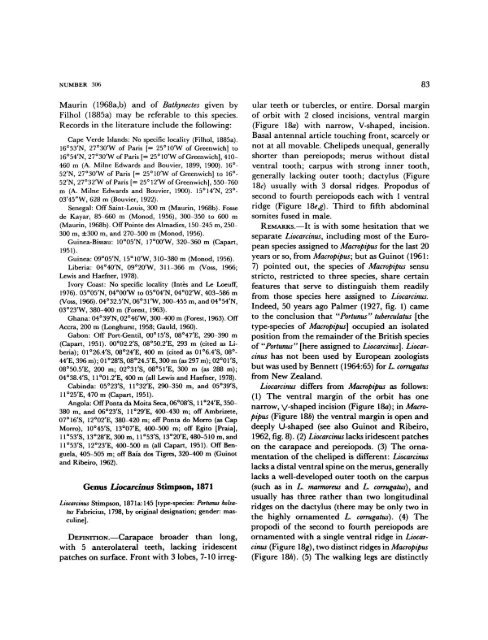West African Brachyuran Crabs - Smithsonian Institution Libraries
West African Brachyuran Crabs - Smithsonian Institution Libraries
West African Brachyuran Crabs - Smithsonian Institution Libraries
You also want an ePaper? Increase the reach of your titles
YUMPU automatically turns print PDFs into web optimized ePapers that Google loves.
NUMBER 306 83<br />
Maurin (1968a,b) and of Bathynectes given by<br />
Filhol (1885a) may be referable to this species.<br />
Records in the literature include the following:<br />
Cape Verde Islands: No specific locality (Filhol, 1885a).<br />
16°53'N, 27°3O'W of Paris [= 25°10'W of Greenwich] to<br />
16°54'N, 27°30'W of Paris [= 25°10'W of Greenwich], 410-<br />
460 m (A. Milne Edwards and Bouvier, 1899, 1900). 16°-<br />
52'N, 27°30'W of Paris [= 25°10'W of Greenwich] to 16°-<br />
52'N, 27°32'W of Paris [= 25°12'W of Greenwich], 550-760<br />
m (A. Milne Edwards and Bouvier, 1900). 15°14'N, 23°-<br />
03'45"W, 628 m (Bouvier, 1922).<br />
Senegal: Off Saint-Louis, 300 m (Maurin, 1968b). Fosse<br />
de Kayar, 85-660 m (Monod, 1956), 300-350 to 600 m<br />
(Maurin, 1968b). Off Pointe des Almadies, 150-245 m, 250-<br />
300 m, ±300 m, and 270-500 m (Monod, 1956).<br />
Guinea-Bissau: 10°05'N, 17°00'W, 320-360 m (Capart,<br />
1951).<br />
Guinea: 09°05'N, 15°10'W, 310-380 m (Monod, 1956).<br />
Liberia: 04°40'N, 09°20'W, 311-366 m (Voss, 1966;<br />
Lewis and Haefner, 1978).<br />
Ivory Coast: No specific locality (Intes and Le Loeuff,<br />
1976). 05°05'N, 04°00'W to 05°04'N, 04°02'W, 403-586 m<br />
(Voss, 1966). 04°32.5'N, 06°31'W, 300-455 m, and 04°54'N,<br />
03°23'W, 380-400 m (Forest, 1963).<br />
Ghana: 04°39'N, 02°46'W, 300-400 m (Forest, 1963). Off<br />
Accra, 200 m (Longhurst, 1958; Gauld, 1960).<br />
Gabon: Off Port-Gentil, 00°15'S, 08°47'E, 290-390 m<br />
(Capart, 1951). 0O°02.2'S, 08°50.2'E, 293 m (cited as Liberia);<br />
01°26.4'S, 08°24'E, 400 m (cited as 01°6.4'S, 08°-<br />
44'E, 396 m); 01°28'S, 08°24.5'E, 300 m (as 297 m); 02°01'S,<br />
08°50.5'E, 200 m; 02°31'S, 08°51'E, 300 m (as 288 m);<br />
04°38.4'S, ll°01.2'E, 400 m (all Lewis and Haefner, 1978).<br />
Cabinda: 05°23'S, 11°32'E, 290-350 m, and 05°39'S,<br />
11°25'E, 470 m (Capart, 1951).<br />
Angola: Off Ponta da Moita Seca, 06°08'S, 11°24'E, 350-<br />
380 m, and 06°23'S, 11°29'E, 400-430 m; off Ambrizete,<br />
07°16'S, 12°02'E, 380-420 m; off Ponta do Morro (as Cap<br />
Morro), 10°45'S, 13°O7'E, 400-500 m; off Egito [Praia],<br />
11°53'S, 13°28'E, 300 m, 11°53'S, 13°20'E, 480-510 m, and<br />
11°53'S, 12°23'E, 400-500 m (all Capart, 1951). Off Benguela,<br />
405-505 m; off Baia dos Tigres, 320-400 m (Guinot<br />
and Ribeiro, 1962).<br />
Genus Uocarcinus Stimpson, 1871<br />
Liocarcinus Stimpson, 1871a: 145 [type-species: Portunus holsatus<br />
Fabricius, 1798, by original designation; gender: masculine].<br />
DEFINITION.—Carapace broader than long,<br />
with 5 anterolateral teeth, lacking iridescent<br />
patches on surface. Front with 3 lobes, 7-10 irreg-<br />
ular teeth or tubercles, or entire. Dorsal margin<br />
of orbit with 2 closed incisions, ventral margin<br />
(Figure 18a) with narrow, V-shaped, incision.<br />
Basal antennal article touching front, scarcely or<br />
not at all movable. Chelipeds unequal, generally<br />
shorter than pereiopods; merus without distal<br />
ventral tooth; carpus with strong inner tooth,<br />
generally lacking outer tooth; dactylus (Figure<br />
18c) usually with 3 dorsal ridges. Propodus of<br />
second to fourth pereiopods each with 1 ventral<br />
ridge (Figure 18*,g). Third to fifth abdominal<br />
somites fused in male.<br />
REMARKS.—It is with some hesitation that we<br />
separate Liocarcinus, including most of the European<br />
species assigned to Macropipus for the last 20<br />
years or so, from Macropipus; but as Guinot (1961:<br />
7) pointed out, the species of Macropipus sensu<br />
stricto, restricted to three species, share certain<br />
features that serve to distinguish them readily<br />
from those species here assigned to Liocarcinus.<br />
Indeed, 50 years ago Palmer (1927, fig. 1) came<br />
to the conclusion that "Portunus" tuberculatus [the<br />
type-species of Macropipus] occupied an isolated<br />
position from the remainder of the British species<br />
of "Portunus" [here assigned to Liocarcinus]. Liocarcinus<br />
has not been used by European zoologists<br />
but was used by Bennett (1964:65) for L. corrugatus<br />
from New Zealand.<br />
Liocarcinus differs from Macropipus as follows:<br />
(1) The ventral margin of the orbit has one<br />
narrow, V-shaped incision (Figure 18a); in Macropipus<br />
(Figure 18b) the ventral margin is open and<br />
deeply U-shaped (see also Guinot and Ribeiro,<br />
1962, fig. 8). (2) Liocarcinus lacks iridescent patches<br />
on the carapace and pereiopods. (3) The ornamentation<br />
of the cheliped is different: Liocarcinus<br />
lacks a distal ventral spine on the merus, generally<br />
lacks a well-developed outer tooth on the carpus<br />
(such as in L. marmoreus and L. corrugatus), and<br />
usually has three rather than two longitudinal<br />
ridges on the dactylus (there may be only two in<br />
the highly ornamented L. corrugatus). (4) The<br />
propodi of the second to fourth pereiopods are<br />
ornamented with a single ventral ridge in Liocarcinus<br />
(Figure I8g), two distinct ridges in Macropipus<br />
(Figure \8h). (5) The walking legs are distinctly

















